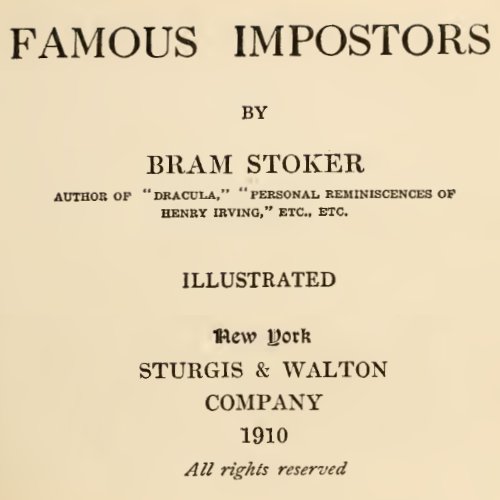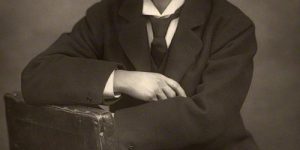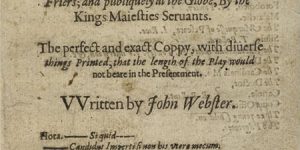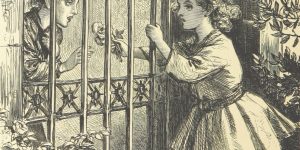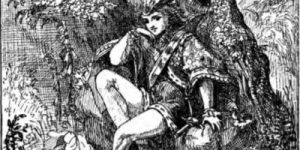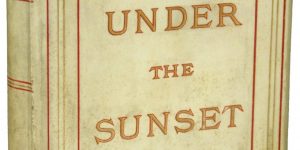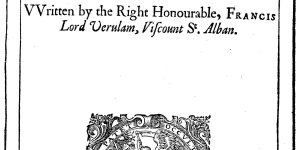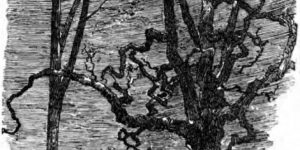The Hidden King : Famous Impostors by Bram Stoker
Famous Impostors : Pretender The Hidden King
by
Bram Stoker
The Hidden King
The personality, nature and life of Sebastian, King of Portugal, lent themselves to the strange structure of events which followed his strenuous and somewhat eccentric and stormy life. He was born in 1554, and was the son of Prince John and his wife Juana, daughter of the Emperor Charles V. He succeeded his grandfather, John III, at the age of three. His long minority aided the special development of his character. The preceptor appointed to rule his youth was a Jesuit, Luiz-Goncalvoz de Camara. Not unnaturally his teacher used his position to further the religious aims and intrigues of his strenuous Order. Sebastian was the kind of youth who is beloved by his female relatives—quite apart from his being a King; and naturally he was treated by the women in a manner to further his waywardness. When he was fourteen years old he was crowned. From thence on he insisted on having his way in everything, and grew into a young manhood which was of the type beloved of an adventurous people. He was thus described:
“He was a headstrong violent nature, of reckless courage, of boundless ambition founded on a deep religious feeling. At the time of his coronation he was called ‘Another Alexander.’ He loved all kinds of danger, and found a keen pleasure in going out in a tempest in a small boat and in actually running under the guns of his own forts where his commands were stringent that any vessel coming in shore should be fired on. He was a notable horseman and could steer his charger efficiently by the pressure of either knee—indeed he was of such muscular vigour that he could, by the mere stringency of the pressure of his knees, make a powerful horse tremble and sweat. He was a great swordsman, and quite fearless. ‘What is fear?’ he used to say. Restless by nature he hardly knew what it was to be tired.”
And yet this young man—warrior as he was, had a feminine cast of face; his features were symmetrically formed with just sufficient droop in the lower lip to give the characteristic ‘note’ of Austrian physiognomy. His complexion was as fine and transparent as a girl’s; his eyes were clear and of blue; his hair of reddish gold. His height was medium, his figure fine; he was vigorous and active. He had an air of profound gravity and stern enthusiasm. Altogether he was, even without his Royal state, just such a young man as might stand for the idol of a young maid’s dream.
And yet he did not seem much of a lover. When, in 1576, he entered Spain to meet Philip II at Guadaloupe to ask the hand of the Infanta Isabella in marriage, he was described as “cold as a wooer as he was ardent as a warrior.” His eyes were so set on ambition that mere woman’s beauty did not seem to attract him. Events—even that event, the meeting—fostered his ambition. When he knelt to his host, the elder king kissed him and addressed him as “Your Majesty” the first time the great title had been used to a Portuguese king. The effect must have come but little later for at that meeting he kissed the hand of the old warrior, the Duke of Alva, and uncovered to him. His underlying pride, however, was shewn at the close of that very meeting, for he claimed equal rights in formality with the Spanish king; and there was a danger that the visit of ceremony might end worse than it began. Neither king would enter the carriage in which they were to proceed together, until the host suggested that as there were two doors they should enter at the same time.
Sebastian’s religious fervour and military ambition became one when he conceived the idea of renewing the Crusades; he would recover the Holy Land from the dominion of the Paynim and become himself master of Morocco in the doing of it. With the latter object in his immediate view, he made in 1574, against the wise counsels of Queen Catherine, a sortie de reconnaissance of the African coast; but without any result—except the fixing of his resolution to proceed. In 1578 his scheme was complete. He would listen to no warning or counsel on the subject even from the Pope, the Grand Duke of Tuscany, or the Duke of Nassau. He seemed to foresee the realization of his dreams, and would forego nothing. He gathered an army of some 18,000 men (of which less than 2,000 were horsemen) and about a dozen cannon. The preparation was made with great splendour—a sort of forerunner of the Great Armada. It seemed to be, as in the case of the projected invasion of England ten years later by Spain, a case of “counting the chickens before they were hatched.”
Some indication of the number of adventurers and camp followers accompanying the army is given by the fact that the 800 craft ordained for the invasion of Morocco carried in all some 24,000 persons, inclusive of the fighting men. The paraphernalia and officials of victory comprised amongst many other luxuries: lists for jousts, a crown ready for the new King of Morocco to put on, and poets with completed poems celebrating victory.
At this time Morocco was entering on the throes of civil war. Muley Abd-el-Mulek, the reigning Sultan, was opposed by his nephew, Mohammed, and to aid the latter, who promised to bring in 400 horsemen, was the immediate object of Sebastian. But the fiery young King of Portugal had undertaken more than he was able to perform. Abd-el-Mulek opposed his 18,000 Portuguese with 55,000 Moors, (of whom 36,000 were horsemen) and with three times his number of cannon. The young Crusader’s generalship was distinctly defective; he was a fine fighting man, but a poor commander. Instead of attacking at once on his arrival and so putting the zeal of his own troops and the discouragement of the enemy to the best advantage, he wasted nearly a week in hunting parties and ineffectual manœuvring. When finally issue was joined, Abd-el-Mulek, though he was actually dying, surrounded the Portuguese forces and cut them to pieces. Sebastian, though he fought like a lion, and had three horses killed under him, was hopelessly beaten. There was an attendant piece of the grimmest comedy on record. The Sultan died during the battle, but he was a stern old warrior, and as he fell back in his litter he put his finger on his lip to order with his last movement that his death should be kept secret for the time being. The officer beside him closed the curtains and went on with the fight, pretending to take orders from the dead man and to transmit them to the captains.
The fate of Sebastian was sealed in that battle. Whether he lived or died, he disappeared on 5 August, 1578. One story was that after the battle of Alcaçer-el-Kebir, his body stripped and showing seven wounds was found in a heap of the slain; that it was taken to Fez and there buried; but was afterwards removed to Europe and found resting place in the Convent of Belen. Another story was that after a brilliant charge on his enemies he was taken in, but having been rescued by Lui de Brito he escaped unpursued. Certainly no one seemed to have seen the King killed, and it was strange that no part of his clothing or accoutrements was ever found. These were of great splendour, beauty and worth, and must have been easily traceable. There was a rumour that on the night following the battle some fugitives, amongst whom was one of commanding distinction, sought refuge at Arzilla.
Alcaçer-el-Kebir was known as the “Battle of the three Kings.” All the principals engaged in it perished. Sebastian was killed or disappeared. Abd-el-Mulek died as we have seen, and Mohammed was drowned in trying to cross the river.
The dubiety of Sebastian’s death gave rise in after years to several impostures.
The first began six years after Sebastian’s successor—his uncle, Cardinal Henry—was placed on the throne. The impostor was known as the “King of Penamacor.” The son of a potter at Alcobaca, he established himself at Albuquerque, within the Spanish borders, somewhat to the north of Badajos, and there gave himself out as “a survivor of the African Campaign.” As usual the public went a little further and said openly that he was the missing Don Sebastian. At first he denied the soft impeachment, but later on the temptation became too great for him and he accepted it and set up in Penamacor, where he became known as the “King of Penamacor.” He was arrested and paraded through Lisbon, bareheaded, as if to let the public see that he in no way resembled the personality of Sebastian. He was sent to the galleys for life. But he must have escaped, for later on he appeared in Paris as Silvio Pellico, Duke of Normandy, and was accepted as such in many of the salons in the exclusive Faubourg St. Germain.
The second personator of Sebastian was one Matheus Alvares, who having failed to become a monk, a year later imitated the first impostor, and in 1585 set up a hermitage at Ericeira. He bore some resemblance to the late king in build, and in the strength of this he boldly gave himself out as “King Sebastian” and set out for Lisbon. But he was arrested by the way and entered as a prisoner. He was tried and executed with frightful accessories to the execution.
The third artist in this imposture appeared in 1594. He was a Spaniard from Madrigal in Old Castile—a cook, sixty years old (Sebastian would have been just forty if he had lived). When arrested he was given but short shrift and shared the same ghastly fate as his predecessor.
The fourth, and last, imposture was more serious. This time the personator began in Venice in 1598, calling himself “Knight of the Cross.”
As twenty years had now elapsed since the disappearance of Sebastian, he would have changed much in appearance, so in one respect the personator had less to contend against. Moreover the scene of endeavour was this time laid in Venice, a place even more widely removed in the sixteenth century from Lisbon by circumstances than by geographical position. Again witnesses who could give testimony to the individuality of the missing King of twenty years ago were few and far between. But on the other hand the new impostor had new difficulties to contend against. Henry, the Cardinal, had only occupied the Portuguese throne two years, for in 1580 Philip II of Spain had united the two crowns, and had held the dual monarchy for eighteen years. He was a very different antagonist from any one that might be of purely Portuguese origin.
In the eyes of many of the people—like all the Latin races naturally superstitious—one circumstance powerfully upheld the impostor’s claim. So long ago as 1587, Don John de Castro had made a seemingly prophetic statement that Sebastian was alive and would manifest himself in due time. His utterance was, like most such prophecies of the kind, “conducive to its own fulfilment;” there were many—and some of them powerful—who were willing at the start to back up any initiator of such a claim. In his time Sebastian had been used, so far as it was possible to use a man of his temperament and position, by the intriguers of the Catholic Church, and the present occasion lent itself to their still-existent aims. Rome was very powerful four centuries ago, and its legions of adherents bound in many ties, were scattered throughout the known world. Be sure these could and would aid in any movement or intrigue which could be useful to the Church.
“The Knight of the Cross”—who insinuated, though he did not state so, that he was a Royal person was arrested on the showing of the Spanish Ambassador. He was a born liar, with all the readiness which the carrying out of such an adventure as he had planned requires. Not only was he well posted in known facts, but he seemed to be actually proof against cross-examination. The story he told was that after the battle of Alcaçer-el-Kebir he with some others, had sought temporary refuge in Arzilla and in trying to make his way from there to the East Indies, he had got to “Prester John’s” land—the semi-fabled Ethiopia of those days. From thence he had been turned back, and had, after many adventures and much wandering—in the course of which he had been bought and sold a dozen times or more, found his way, alone, to Venice. Amongst other statements he alleged that Sebastian’s confessor had already recognised and acknowledged him; but he was doubtless ignorant, when he made the statement, that Padre Mauricio, Don Sebastian’s confessor, fell with his king in 1578. Two things, one, a positive inference and the other negative, told against him. He only knew of such matters as had been made public in depositions, and he did not know Portuguese. The result of his first trial was that he was sent to prison for two years.
But those two years of prison improved his case immensely. In that time he learned the Portuguese language and many facts of history. One of the first to believe—or to allege belief, in his story, Fray Estevan de Sampayo, a Dominican monk, was in 1599, sent by the Venetian authorities to Portugal to obtain an accredited description of the personal marks of King Sebastian. He returned within a year with a list of sixteen personal marks—attested by an Apostolic notary. Strange to say the prisoner exhibited every one of them—a complete agreement which in itself gave rise to the new suspicion that the list had been made out by, or on behalf of, the prisoner. The proof however was accepted—for the time; and he was released on the 28th of July, 1600—but with the imperative, humiliating proviso that he was to quit Venice within four and twenty hours under penalty of being sent to the galleys. A number of his supporters, who met him before he went, found that he had in reality no sort of resemblance to Sebastian. Don John de Castro, who was amongst them, said that a great change in Sebastian seemed to have taken place. (He had prophesied and adhered to his prophecy.) He now described him as a man of medium height and powerful frame, with hair and beard of black or dark brown, and said he had completely lost his beauty. “What has become of my fairness?” the swarthy ex-prisoner used to say. He had eyes of uncertain colour, not large but sparkling; high cheek bones; long nose; thin lips with the “Hapsburg droop” in the lower one. He was short from the waist up. (Sebastian’s doublet would fit no other person.) His right leg and arm were longer than the left, the legs being slightly bowed like Sebastian’s. He had small feet with extraordinarily high insteps; and large hands. “In fine,” Don John summed up illogically, “he is the self-same Sebastian—except for such differences as resulted from years and labours.” Some other particulars he added which are in no way helpful to a conclusion.
The Impostor told his friends that he had in 1597, sent a messenger from Constantinople to Portugal—one Marco Tullio Catizzone—who had never returned. Thence he had travelled to Rome—where, when he was just on the eve of being presented to the Holy Father, he was robbed of all he had; thence to Verona and so on to Venice. After his expulsion from Venice he seems to have found his way to Leghorn and Florence, and thence on to Naples, where he was handed over to the jurisdiction of the Spanish Viceroy, the Count of Lemos, who had visited him in prison, and who well remembered King Sebastian whom he had seen when in a diplomatic mission. The Viceroy came to the conclusion that he bore no likeness at all to Sebastian, that he was ignorant of all save the well known historical facts that had been published, and that his speech was of “corrupt Portuguese mingled with tell-tale phrases of Calabrian dialect.” Thereupon he took active steps against him. One witness who was produced, recognized in him the real Marco Tullio Catizzone, and Count de Lemos sent for his wife, mother-in-law and brother-in-law, all of whom he had deceived and deserted. His wife, Donna Paula of Messina, acknowledged him; and he confessed his crime. Condemned to the galleys for life, Marco Tullio, out of consideration of a possibility of an error of justice, was so far given indulgence by the authorities that he did not have to wear prison dress or labour at the oar. Many of his supporters, who still believed in him, tried to mitigate his lot and treated him as a companion; so that the hulk at San Lucar, at the mouth of the Guadalquiver became a minor centre of intrigue. But still he was not content, and adventuring further, he tried to get money from the wife of Medina-Sidonia then Governor of Andalusia. He was again arrested with some of his associates. Incriminating documents were found on him. He was racked and confessed all. And so in his real name and parentage, Marco Tullio, son of Ippolit Catizzone of Taverna, and of Petronia Cortes his wife, and husband of Paula Gallardetta was executed. He had, though of liberal education, never worked at any occupation or calling; but he had previously to his great fraud, personated other men—amongst them Don Diego of Arragon. On 23rd of September, 1603, he was dragged on a hurdle to the Square of San Lucar; his right hand was cut off and he was hanged. Five of his companions, including two priests, shared his fate.
But in a way he and the previous impostors had a sort of posthumous revenge, for Sebastian had now entered into the region of Romantic Belief. He was, like King Arthur, the ideal and the heart of a great myth. He became “The Hidden King” who would some day return to aid his nation in the hour of peril—the destined Ruler of the Fifth Monarchy, the founder of an universal Empire of Peace.
A hundred years ago, the custom in British theatres was to finish the evening’s performance with a farce. On this occasion the tragedy had been finished two centuries before the “comic relief” came. The occasion was in the French occupation of Portugal in 1807. The strange belief in the Hidden King broke out afresh. A rigorous censorship of Sebastianist literature was without avail—even though its disseminators were condemned by the still-existing Inquisition. The old prophecy was renewed, with a local and personal application—Napoleon was to be destroyed in the Holy Week of 1808, by the waiting Sebastian, whose approach from his mysterious retreat was to be veiled with a thick fog. There were to be new portents; the sky was to be emblazoned with a cross of the Order of Aviz, and on March 19th a full moon was to occur during the last quarter. All these things were foretold in an egg, afterwards sent by Junot to the National Museum. The general attitude of the French people towards the subject was illustrated by a remark in an ironical manner of one writer: “what can be looked for from a people, one half of whom await the Messiah, the other half Don Sebastian?” The authority on the subject of King Sebastian, M. d’Antas, relates that as late as 1838, after the crushing of a Sebastianist insurrection in Brazil certain still believing Sebastianists were to be seen along the coast peering through the fog for the sails of the mythical ship which was to bring to them the Hidden King who was then to reveal himself.
Famous Impostors
Chapter I. Pretenders
A. Perkin Warbeck
B. The Hidden King
C. Stephan Mali
D. The False Dauphins
E. Princess Olive
Chapter II. Practitioners of Magic
A. Paracelsus
B. Cagliostro
C. Mesmer
Chapter III.
The Wandering Jew
Chapter IV.
John Law
Chapter V. Witchcraft and Clairvoyance
A. Witches
B. Doctor Dee
C. La Voisin
D. Sir Edward Kelley
E. Mother Damnable
F. Matthew Hopkins
Chapter VI.
Arthur Orton (Tichborne claimant)
Chapter VII. Women as Men
A. The Motive for Disguise
B. Hannah Snell
C. La Maupin
D. Mary East
Chapter VIII. Hoaxes, etc.
A. Two London Hoaxes
B. The Cat Hoax
C. The Military Review
D. The Toll-Gate
E. The Marriage Hoax
F. Buried Treasure
G. Dean Swift’s Hoax
H. Hoaxed Burglars
I. Bogus Sausages
J. The Moon Hoax
Chapter IX.
Chevalier d’Eon
Chapter X.
The Bisley Boy

